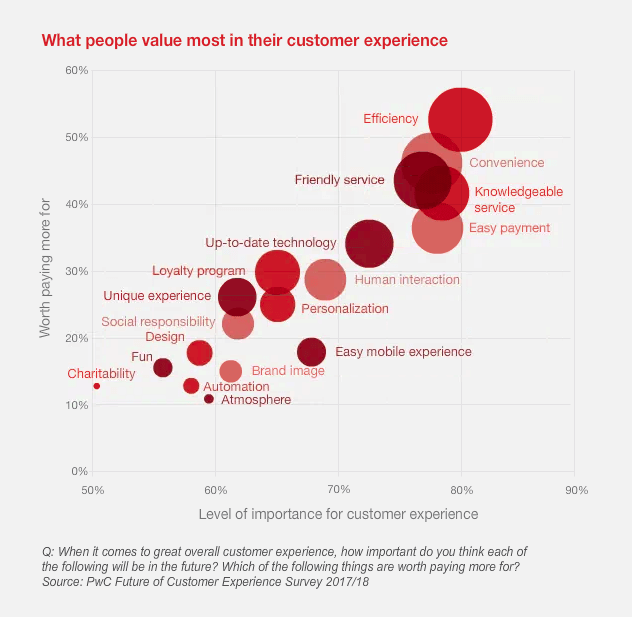
3 Ways To Make Your Customer Service Experience More Human
Think about your favorite brand. What comes to mind? Is it the feel-good fuzzies you get when you remember your trip to Disney World three years ago? Or the oh-so-powerful moment where you set your personal record on a run in your trusty Brooks.
You have a collection of interactions, a tiny jar in your brain filled with moments and experiences from different companies.
But, what comes to mind when you think about one of those experiences that wasn’t the greatest?
Do you think about the time you read an article you swear you could’ve written better yourself? (Just me?) Or, do you think about how you spent two hours on hold only to be greeted by a disdainful customer service rep who quickly brushed your complaint under a rug full of similar dust bunnies?
Download Now: Improve your customer service experience with strategies backed by data about what your customers really want.
The worst memories you have with brands probably resemble the latter. A sub-par blog post doesn’t have the staying power to take up coveted room in the tiny jar in your brain. But a particularly poor interaction with a service rep, does.
That’s because our personal interactions and connections mean more to us as humans than nearly anything else. We remember when we were treated poorly by another person. We remember when our concerns were dismissed, or a frustrated rep didn’t have time to help us. And, that’s why we need to focus on making the customer service experience more human.
Here’s how to prioritize the people aspect of your customer service experience:
Make interactions more than simple transactions
Many people think of customer service as only the transactional, problem-solving moments with customers. While the customer experience is deemed king AND queen in terms of business. But the customer service experience is arguably the most important piece of the overall customer experience.
In fact, 82% of customers left a company because of bad customer service. Given that customer service is what often makes or breaks a person’s relationship with a brand, it’s crucial to think of every interaction as the end note. When your agents leave a conversation, can they say with confidence that the customer will continue to do business with you? Or, at least that they didn’t quit on your brand because of their service experience? Putting more weight on every customer interaction will encourage a shift from the transactional mindset.
When customers come to your agents with problems, it’s second nature to want to solve those problems as quickly as possible. There’s a certain “let’s get this over with and move on to the next one,” mentality. Not to mention, those fickle efficiency metrics your agents have to keep top-of-mind.
But your customers experience rides on the friendly and knowledgeable service your agents deliver in-the-moment. And often, that level of attention means slowing down to listen to the customer, then finding a lasting solution, not a fast one.
Encourage agents to take the few extra moments to create a connection with each customer. Even if they simply press pause to say, “Hey, how are you today?” Efficiency still needs to be a priority in the contact center. But find ways to slip feel-good moments into every customer interaction.
Learn how knowledgeable and friendly agents earn customers for life.
Keep a pulse on your agent experience
Happy agents deliver happy experiences. Check in with your agents and keep a pulse on their mood, workload and goals. See if they’re meeting expectations, taking calls and doing it with a positive attitude.
If agents are falling short in one area, they’re more likely to become frustrated – an emotion that comes through loud-and-clear in customer interactions. If you don’t get the agent experience right, your agents won’t hand off positive experiences to your customers. Focus on your internal customers, first.
Check in with your agents regularly. Look to your data for information on how they’re performing, where they need help and how engaged they are at work. Trigger a one-question survey at the end of each day, asking agents how they feel about their jobs. And, look at your KPIs through the lens of your agent experience. If agents are struggling to get through their queue each day, are other aspects of their experience holding them back? How much have you invested in training per agent this year?
Getting clear, distilled insights about your agents gives you the details you need to keep them happy. And to help them perform like all-stars. When you have a team full of all-stars, there’s no doubt they’ll take the extra few seconds to serve delightful, human moments to your customers.
When your agents get a better experience at work, they deliver better experiences to your customers. See the nine ways business outcomes improve when you invest in agents.
Close the gaps in the customer service experience
Clunky software and mismatched channels cause pain in the customer service experience for your customers. And we’re talking serious pain, not knee-scrape pain. (Refer back to the tiny memory jar where you spent two hours on hold.)
Nearly 80% of consumers identified speed, convenience, knowledgeable help, and friendly service as the foundational elements of a positive experience.

Instantly, you can see how integral customer service is to the entire customer experience. Customer service wins out over the fun factor – like having a lively brand or an engaging mobile experience. And two of the top-ranking factors (knowledgeable and friendly service), are determined solely by your agents humanizing customer service.
Ditch disjointed channels in favor of tools that work together for your agents and customers. Then, agents can focus on the moments that matter, the moments of truth, defined by McKinsey & Co as moments where customers expend energy to seek the best outcome.
If a customer invests emotional energy in an interaction, the human thing to do is reciprocate. These moments of truth are the exact instances where agents can truly connect with customers and deliver exceptional customer service.
But if your agents battle with outdated processes and inefficient technology, they’ll likely miss prime opportunities for connection with customers.
Help close the gap by giving your agents quicker access to the information they need. Seek out omnichannel tools that wrap your reporting, channels, and quality management all into a single platform. The extra efficiency paves the way for more human interactions and less fussing with technology.
Lean into what your customers really want. Inform your customer experience strategies using the customer data that lives in your contact center.
We originally published this post on August 3, 2018 and we updated it for new insight on June 12, 2020.

